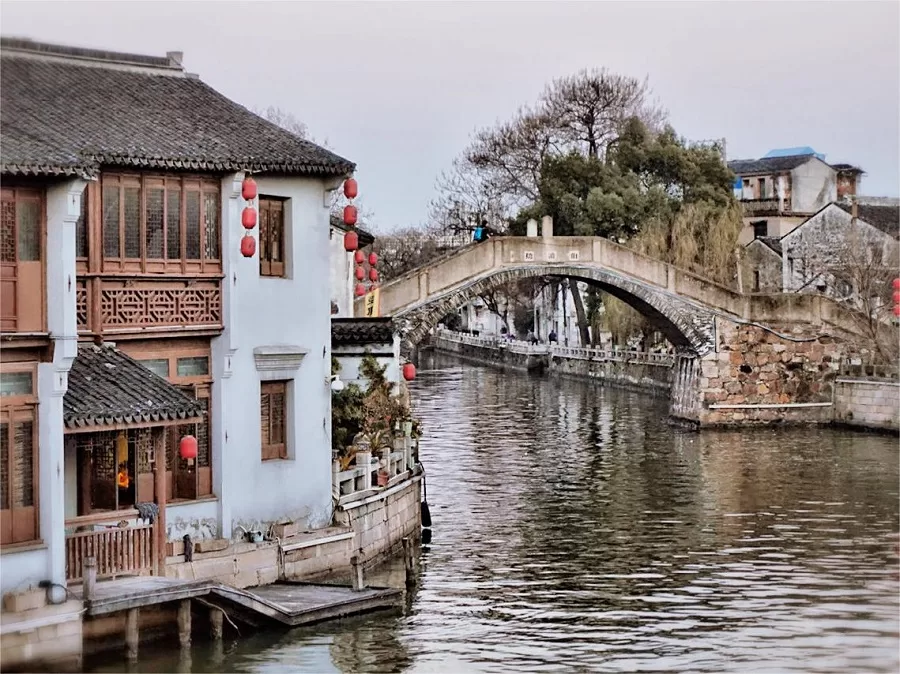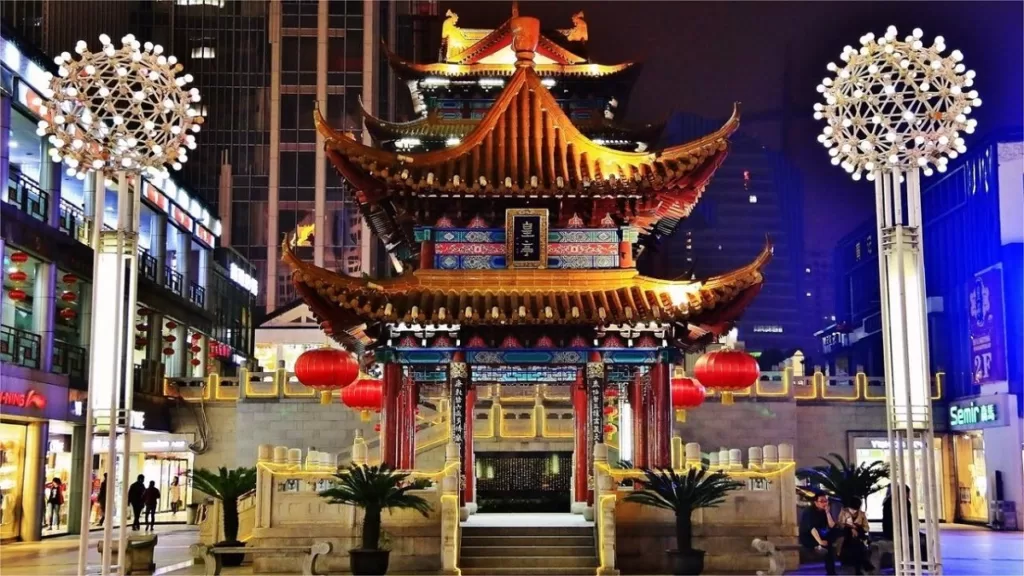Nanchang Street (南长街), located in the bustling heart of Wuxi, Jiangsu Province, is an integral part of the UNESCO World Cultural Heritage site, the Grand Canal. It comprises several areas, including the Grand Canal Ancient Town, Nanxiang Tang, Bodu Port, and Dayao Road.
Covering an area of 18.78 hectares, the Grand Canal Ancient Town preserves a unique urban layout with roads and waterways running parallel, embodying the classic charm of a Jiangnan water town. It features small bridges, flowing water, traditional residences, and enchanting ancient alleys, with over a hundred historical buildings and nine ancient bridges, making it a quintessential representation of Jiangnan water alleys.
One of its most significant historical landmarks is the “Qingming Bridge,” constructed during the Ming Dynasty, spanning the Grand Canal and serving as a vital cultural symbol within the district. Nanchang Street stands as a testament to the rich history and cultural heritage of this vibrant region.
Table of Contents
- Basic Information
- Location and Transportation
- Highlights of Nanchang Street
- Vlog about Nanchang Street
- Useful Tips Summarized from Reviews
- Attractions near Nanchang Street
Basic Information
| Estimated Length of Tour | 2 hours |
| Ticket Price | Free |
| Opening Hours | 24 hours a day |
| Telephone Number | 0086-0510-82827975 |
Location and Transportation
Nanchang Street is situated in Wuxi, extending from the southern gate of the old city to Xinguang Road, covering a total length of 5.5 kilometers. It is centered around the Grand Canal, with Qingming Bridge as its focal point. Nanchang Street stretches from the north at Kuatang Bridge to the south at Nanshuixian Temple, from the east at the former Wang Yuanji Iron Pot Factory site to the west along the banks of Ding Sheng River. To get to Nanchang Street:
By Metro:
- Take Metro Line 1 and get off at “Nanchansi Station – Exit 8.”
- Walk south for approximately 8 minutes to reach the entrance of Qingming Bridge Historical and Cultural District (Cong Guifang).
By Bus:
- Routes like 15, 24, 27, 57, 105, 358, 502, 703, 765, 788-1, and 788-2 will take you to Kuatang Bridge (Nanchang Street). Walk approximately 100 meters to reach the entrance of Nanchang Street.
Highlights of Nanchang Street
Qingming Bridge

Qingming Bridge is a prominent architectural landmark located within Nanchang Street and is the largest surviving ancient stone arch bridge in Wuxi’s urban area. This historical gem dates back to the Wanli era of the Ming Dynasty and was constructed with contributions from two sons of Qin Yao, the owner of the Jichang Garden. These brothers were named Taiqing and Taining, so the bridge was initially named Qingning Bridge, combining a character from each of their names.
In the 8th year of the Kangxi era (1666 AD), during the Qing Dynasty, Wuxi County Magistrate Wu Xingzuo oversaw its reconstruction. However, during the Daoguang era, when the bridge’s name contained a character associated with the emperor’s name, it was changed to Qingming Bridge.
Dagong Bridge

Dagong Bridge, nestled in Nanchang Street, holds a poignant history. In the early 20th century, the area around Nanshang and Xiatang had thirteen silk factories, and female workers frequently had to cross the canal by boat. In 1929, a tragic incident occurred when a worker from Zhenyi Silk Factory drowned during a ferry crossing. To ease tensions, factory owner Xu Daosun spearheaded a fundraising effort to build a bridge. Upon hearing of this endeavor, Rong Desheng also contributed to the construction. The bridge, located between Qingming Bridge and Kuatang Bridge, was completed in April 1930 and was named “Dagong,” symbolizing the unity and cooperation of the workers.
China Silk Industry Museum

The China Silk Industry Museum, originally the Yongtai Silk Factory, is a captivating attraction located on Nanchang Street. This museum showcases the rich history of China’s silk industry through five distinct exhibition areas: “Silk Kingdom,” “Century of Splendor,” “Silk Cocoon and Reeling,” “Printing and Dyeing Fashion,” and “Performance and Sales.” Through authentic design and exhibition techniques, the museum faithfully recreates indoor scenes and brings to life the historical grandeur of the Yongtai Silk Factory and the significance of Wuxi as a key player in China’s silk industry history. It serves as a testament to Wuxi’s enduring legacy in the world of silk production.
Relics of Klin Group

The relics of the Kiln Group in Nanchang Street hold a significant historical legacy. The pottery and porcelain kilns along Dayao Road date back to the Ming Dynasty but reached their zenith during the Qing Dynasty and the Republic of China era. During the Jiaqing era, they were even responsible for producing gold bricks for the Forbidden City. Along the Dayao Road, you can still find ancient kilns stretching over 1.5 kilometers. Records suggest that there were originally 100 kilns, with 42 remaining today, and about 19 of them are relatively well-preserved, offering a fascinating glimpse into the history of ceramic production in this area.
South Water Deity Temple

Originally known as the Songzi Wanghou Temple, the South Water Deity Temple is situated in the southern section of Nanchang Street. It was established in honor of Wang Qiqin, the magistrate of Wuxi County who led the local people in resisting Japanese invaders during the Ming Jiajing period. The temple also commemorates the thirty-six brave individuals, including He Wulu, who sacrificed their lives during the anti-Japanese resistance. Due to its proximity to the Grand Canal, worshippers arriving by boat commonly referred to it as the South Water Deity Temple. This temple serves as a historical testament to the valor and sacrifice of those who defended the region during times of adversity.
Foodie Paradise

Nanchang Street is a foodie paradise where culinary delights abound. One must-try dish is the Wuxi Three Fresh Dumplings, featuring fillings crafted from fresh meat, dried shrimp, and preserved vegetables. Served with a flavorful bone broth, tofu strips, and egg skin, these dumplings are a burst of umami goodness. For a sweet treat, indulge in the delectable Ma Ti Su, a pastry made from a blend of flour, malt, lard, sesame, and sugar, baked to perfection. The result is a crispy exterior and a soft, fragrant, and sweet interior. Nanchang Street’s culinary offerings promise an unforgettable journey through the tastes and traditions of Wuxi.
Vlog about Nanchang Street
Useful Tips Summarized from Reviews
Architectural Charm for Photography: Nanchang Street is very long, featuring architecture with a pure Jiangnan style, making it perfect for photography.
Picturesque Tea Houses on the Ancient Canal’s East Bank: On the east bank of the ancient canal, there are numerous picturesque tea houses where you can sit and enjoy the scenery. The east bank also boasts many folk music bars.
Music Market and Free Performances: Heading southeast along Nanchang Street, you’ll encounter the “Music Market,” featuring a terrace-built stage and seating for audiences, all free of charge. There are also many open-air food carts where you can sit down and enjoy a drink.
Wuxi’s Sweet Trio (三件套): For dessert lovers, indulge in Wuxi’s sweet trio: Wuxi Xiaolongbao (small steamed buns), Sanxian Wonton (three fresh ingredients dumplings), and Sauce Spare Ribs.






